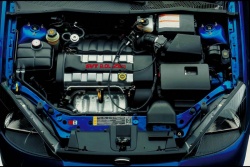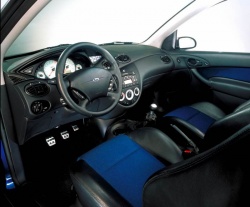 2004 Ford Focus SVT four-door. Click image to enlarge |
By Jeff Burry
Most automotive enthusiasts are no stranger to Ford’s SVT (Special Vehicle Team), a group of performance experts and engineers produce specially tuned versions of Ford production vehicles.
In recent years, this special arm of Ford Motor Company have added their tuner touch to the likes of the Ford F-150 (SVT Lightning), Mustang (SVT Cobra) and even the four-door Contour (SVT Contour).
The Focus was introduced to Canada in 1999 by Ford as its then-latest entry into the compact car market. This particular model replaced the Ford Contour/Mercury Mystique and Ford Escort and even won North American Car of the Year Award in 2000.
With annual production numbers nearing the 270,000 mark for the 2000 model year, Ford executives decided that the buying public might be interested in a specially-tuned version of this hot selling little car; a hand-off to the SVT group was imminent.
Within a matter of months the SVT Focus was born and launched within the North American market for the 2002 model year. While at a glance one might not be able to distinguish the “grocery-getter” Focus from its fire-breathing brother, it was what lay under the hood that separated these siblings.
At the time, the 2002 SVT Focus was the most technologically advanced Ford that the SVT group ever laid their hands on. Ford’s tried and proven DOHC (Double Over Head Cam) 16 valve Zetec 2.0-litre was completed with expertise, compliments of Cosworth (of Formula 1 fame).
  2004 Ford Focus SVT four-door. Click image to enlarge |
The collaboration between both teams produced a naturally aspirated engine that achieved 170 horsepower and 145 lb.-ft. of torque at only 5,500 rpm (the 2002 Ford Mustang GT with 4.6-litre engine only produced 90 horsepower more).
Its low-end torque was perhaps the most astonishing, producing 85 per cent of its peak before 2,200 rpm. Zero to 100 km/h times were typically clocked in the 7.6 second range.
Other tweaks included new larger pistons to raise the compression from 9.6:1 to 10.2:1, upgraded cam profiles, the addition of variable intake-cam timing (delivering the maximum amount of air to the intake ports), a new dual-stage intake manifold and 4-2-1 tubular exhaust header.
A dual-mass flywheel (a first for a front-wheel drive Ford product sold in North America) was also utilized to eliminate vibration and transmission noise. This was hooked up to a Getrag six-speed manual transmission with a twin layshaft design. Needless to say, with a keen eye towards performance, not one component of the drivetrain was overlooked by both the SVT and Cosworth teams.
To assist in taming this rather unruly member of the family, Ford added larger disc brakes on each of the four corners, stiffened the suspension and increased the diameter of the anti-roll bars.
The exterior was also given a modest face-lift which included upgraded front, side and rear fascias, with the front fascia sporting a set of lower driving lights. If that wasn’t enough, the SVT Focus was further equipped with 17-inch rims wrapped in 215/45R17 high-performance tires.
Approximately 4,800 SVT Focuses rolled off the assembly line for the 2002 model year with another 6,100 being produced for 2003. Potential buyers in 2003 could now select a slightly more practical five-door model as well.
  2004 Ford Focus SVT four-door. Click image to enlarge |
To provide the three-door model with still more “pop,” a new European Appearance package was available, which featured an upscale interior including leather-trimmed seating surfaces (front and rear) and matching leather door panel inserts. Dark Argent wheels now complimented two new “performance” colours – Screaming Yellow and Competition Orange.
For the last and final year of production (2004), Ford manufactured another 3,057 SVT versions of the Focus bringing the total production numbers for all three model years to just over 14,000 units. However, sales were not exactly brisk, despite the exciting ride that was promised. There were any number of reasons for that, not the least of which was the price.
The original Canadian price-tag for the 2002 was $27,595, which dropped to $26,915 by the 2004 model year. These costs, before taxes, were approximately $7,000 more than the regular Focus model, which, perhaps was enough to keep some potential buyers away.
Today, these cars can be acquired for well under $8,000. However, a well-preserved sample with under 100,000 km will set you back anywhere in the neighbourhood of $8,000 to $10,000.
It should be pointed out that the SVT did an amazing job in balancing ride comfort given all the enhancements that were made to the chassis and suspension, which typically, would simply deliver a “stiffer” ride. All in all, the SVT Focus adds up to a pretty good bargain if one is looking to balance practicality with performance from a North American vehicle.
Will it ever reach collector status? Who knows, but you can be sure that however many remain on the roads of North America and beyond, the SVT Focus is still putting smiles on the faces of its owners. I’d be willing to bet that somewhere in North America there is a garage filled with a Mustang, Contour, F-150 and Focus – all from the folks at SVT. How cool is that?
For further light reading on the SVT group and its creations, go to SVTPerformance.com







 Follow Autos on Twitter
Follow Autos on Twitter



